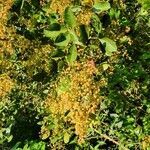Quite glabrous; leaves petiolate; leaflets sessile, oval, obtuse, emarginate, crenate-ser-rate, cuneate at base, penninerved, paler beneath; racemes axillary, simple, or sub-paniculate, shorter than the leaves; drupe sub-globose, glabrous. Branches terete, greyish, punctate, scabrous. Leaves 1.5-2 inches long, 9-12 lines wide. Petioles terete, furrowed above, 3/4-1 inch. Racemes 0.5-1,5 uncial, simple or at the top paniculated; pedicels capillary, 1-1,5 lines long. Flowers minute, white. Calyx and petals obtuse. Drupe yellowish-brown, of the size of a small pea.
A shrub. It grows to 6 m tall. The branches are rough and grey. The leaves have 3 leaflets. The leaves are leathery. They are a darker green on the upper surface than the lower surface. The leaflets are oblong and narrowing to the base. The tip is notched or bluntly pointed. The central leaflet is up to 9 cm long and 4 cm wide. Young leaves are a red colour. The flowers are small and greenish-white. They occur in branched bunches in the axils of leaves. The fruit are small, round or somewhat flattened and yellow-brown when ripe. They are edible.
Tree or shrub, 1-5 m high; evergreen, unarmed, semi-scandent; bark grey-brown, granular, lenticellate, branchlets glabrous. Leaves: petioles somewhat margined, trifoliolate; leaflets sessile, subcoriaceous, glabrous, dark green above, light green below, elliptical, weakly undulate, margins crenulate in upper 2/3, slightly thickened. Flowers small, greenish yellow. Inflorescence axillary and terminal panicles, ± 70 mm long, lax, sparsely branched, exposed. Fruit a drupe, circular to oblate, globoid, glabrous, shiny, chestnut-to cinnamon-brown.


